At the end of one of my almost daily swims, I grabbed a scrub brush to clean up Two Fish’s water line. She still had the brown tint of the Rio Plata and some orange by-product from the engine exhaust. The proper technique is to use the paddleboard and our suction cup clamps as a sturdy platform to vigorously scrub the topsides. However, my focus was on goofing around more than on proper boat work. The less efficient technique that I employed was treading water, and swiping at the boat with the brush. My apologies to graduates of the nautical sanitation engineers college.
During the scrubbing of the waterline, the “two of everything” on a catamaran became tiresome. While scrubbing away, I felt like I was cleaning a grossly over-sized MacMansion (a 7,000 square foot suburban home). Two 44 foot hulls equal an 88 foot yacht . This was just a passing thought, as I was enjoying thrashing in the water like an over-the-hill water polo player. I kicked hard to reach parts of the topsides that were a few feet out of the water only to have gravity pull me back. Overall, the topsides are in good shape – no dings yet in the gelcoat from poor docking. It will happen someday – like a first ding in a new car.
As I was finishing up my cleaning project, I chose to dive under the boat to check the propeller. We have 4-blade feathering props. While sailing, the blades feather to create less drag. I was greeted by a bird’s nest of small diameter polypropylene line wrapped around the prop shaft. I was excited – a real job that requires swimming.
In order to set the right tone, I informed Gail of the importance and potential danger of the mission. She cobbled together gear to help increase my chances of surviving unscathed: gloves, a folding knife with a serrated blade, and a dive line (Gail rigged a line from the toe rail abeam to the propeller for my use while descending). All was set for a scene from a Bond film as I could use my knife to cut an enemy’s air supply. Without frogmen to distract me, I made short work of the festooned prop shaft. My technique was to cut the line with the blade facing away and then try pulling at the mess to remove loose bits. I had two concerns – one rational and the other crazy. Crazy was my fear that the engine could come alive and in no time the propeller would become a Cuisinart producing a fresh batch of Jason burgers.
- Left to right (prop, shark shank, prop strut, zinc anodes)
- Your average buccaneer
- Hard at work … enjoying it very much
- The culprit
The less dramatic risk that had a real probability was my concern of cutting myself on the Shark Shafts. We had Shark Shafts installed on both prop shafts. The Shark Shafts are after-market serrated knife rings added to our propeller shafts to cut lines away that might otherwise foul the prop. Do we like them? Without a video camera down by the prop, we will never know their efficacy. While diving, I wished they were not there. When Two Fish first hooked the fishing line, did the Shark Shafts cut enough of the line to keep the props running fine? Instead of a mid-ocean repair, all I had was an at-anchor clean up? There was evidence that something sharp had damaged the fishing line. Shark Shafts are like a flu shot – you never really know if they worked.
A few paddle board photos to end the post.

- Paddleboarding
- Gail in burkini off for a paddle
- Dinghy paddle serves double duty on the paddleboard
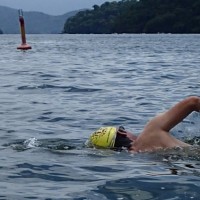
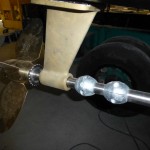
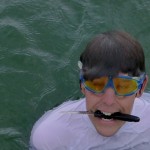
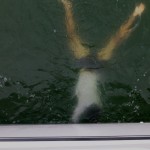
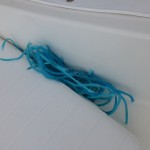



4 Responses to Two Fish is hooked by a fishing line